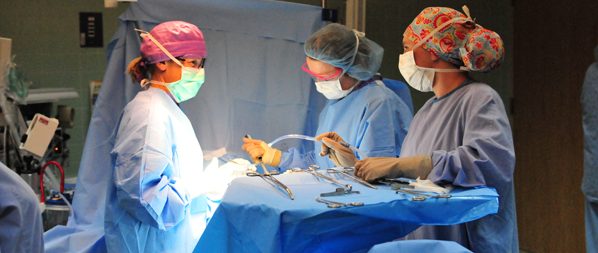Are Breast Implants Safe?

Breast implants are the nation’s most popular cosmetic procedure; nearly 300,000 woman had breast reconstruction last year. But are their breast implants safe?
Breast implants are the nation’s most popular cosmetic procedure. As a grown woman, a bigger bust may feel like a dream come true — sometimes after years of feeling shy about your bustline. Nearly 300,000 women in the United States chose breast augmentation in 2016, according to the American Society of Plastic Surgeons, up 4 percent from 2015. The next most popular procedure was liposuction.
Women who have had some or all of a breast removed to fight breast cancer may decide against the “flat breast” look, choosing an implant to look and feel more like they did before. More than 100,000 American women in 2016 received an implant for reconstruction after breast cancer.
What are the risks of breast impants?
If you’re asking yourself, “Are breast implants safe?” the answer is that the surgery is safer than many things you do every day — driving a car, for example. Still, this is an optional procedure, and every woman needs to weigh the emotional benefits she expects against the known health risks of implants. It’s also true that other risks of breast implants may emerge down the road.
You should definitely be prepared for the possibility of a second surgery. Within the first eight to 10 years after the surgery, between 20 to 40 percent of augmentation patients and 40 to 70 percent of reconstruction patients had another operation to modify, remove, or replace their implant, according to a 2011 review of silicone implants reported by the Food and Drug Administration (FDA).
YOU MIGHT ALSO LIKE: 8 Little Known Breast Cancer Facts
Types of breast implants
Silicone implants have had the worst publicity, after fears linking them to various illnesses. All implants are made from a silicone envelope, but the envelope can contain either silicone gel or salt-water. The risks of saline and silicone implants are similar. The FDA approved salt-water implants in 2000, and in 2006 reviewed the evidence and approved a group of silicone gel implants for all women. In recent years, two new brands of silicone implants received approval. The FDA now reports that there are no clear links between silicone breast implants and breast cancer, reproductive problems, or diseases of the connective tissues — risks that have been studied. But if a disease is rare or slow to emerge, we may not identify it until there are bigger, longer-term studies.
In March 2017, the agency announced that it had received a total of 359 reports of a rare cancer associated with silicone implants called anaplastic large-cell lymphoma — not breast cancer. Nine women had died. Usually the illness is treatable, often by removing the implant and the tissue around it, but some women may need chemotherapy and radiation.
The cancer was much more common with textured implants, compared to smooth ones, and somewhat more common with implants filled with silicone gel. Of 312 cases in which the agency had data, 186 of the implants were filled with silicone gel, and 126 with saline.
However, if you don’t have a cancer, the agency said, the latest discovery isn’t a reason to remove an implant, since the cancer is rare. Seek medical advice if you notice swelling, pain, or lumps.
The known risks of breast implants include local complications, leaks, need for second surgery, auto-immune reactions, and late breast cancer detection.
Local complications
You may experience an infection, breast pain, or numb breasts or nipples, as well as leakage. The FDA has a consumer handbook with photographs and explanations of common complications.
Your breasts can feel painful if scar tissue forms inside your breast. It’s normal for women who have reconstructed breasts after cancer to lose some sensation.
Disappointment
Most women are happy with the appearance of their breasts after the surgery. Some women say their breasts look or feel unnatural or asymmetrical, or that they can hear a “sloshing sound” from saline implants. Be careful if you are getting a breast implant because you believe it will solve other problems in your life — a bad marriage, for example. A 2016 review found that women with implants are more likely to commit suicide than women who don’t have an implant.
If you gain or lose weight, a breast without an implant may change size and become less closely matched to the breast with the implant.
Breakdown of the implant
No implant will last forever. The FDA recommends that women with silicone implants have their breast screened by MRI three years after the surgery to make sure it isn’t leaking silicone, called a “silent rupture.” Silicone can travel from the site of the implant to other parts of the body.
Auto-immune symptoms
Some women develop autoimmune symptoms like fatigue and muscle aches that may be related to leaking silicone, studies suggest. This appears to still be the case with the newer implants, according to a 2016 study. Among a group of 54 patients who had a silicone-gel breast implant removed because of these symptoms, 27 said that their symptoms improved after the surgery. If you have a personal or family history of autoimmune disease, an implant would be risker.
Late breast cancer detection
Implants can make mammograms for breast cancer more difficult to read, and early research suggests that women with breast implants are slightly less likely to survive breast cancer, probably because of a delay in diagnosis.
YOU MIGHT ALSO LIKE: Anxiety Can Kill if You Avoid Breast Cancer Screenings
Updated:
February 27, 2020
Reviewed By:
Janet O’Dell, RN